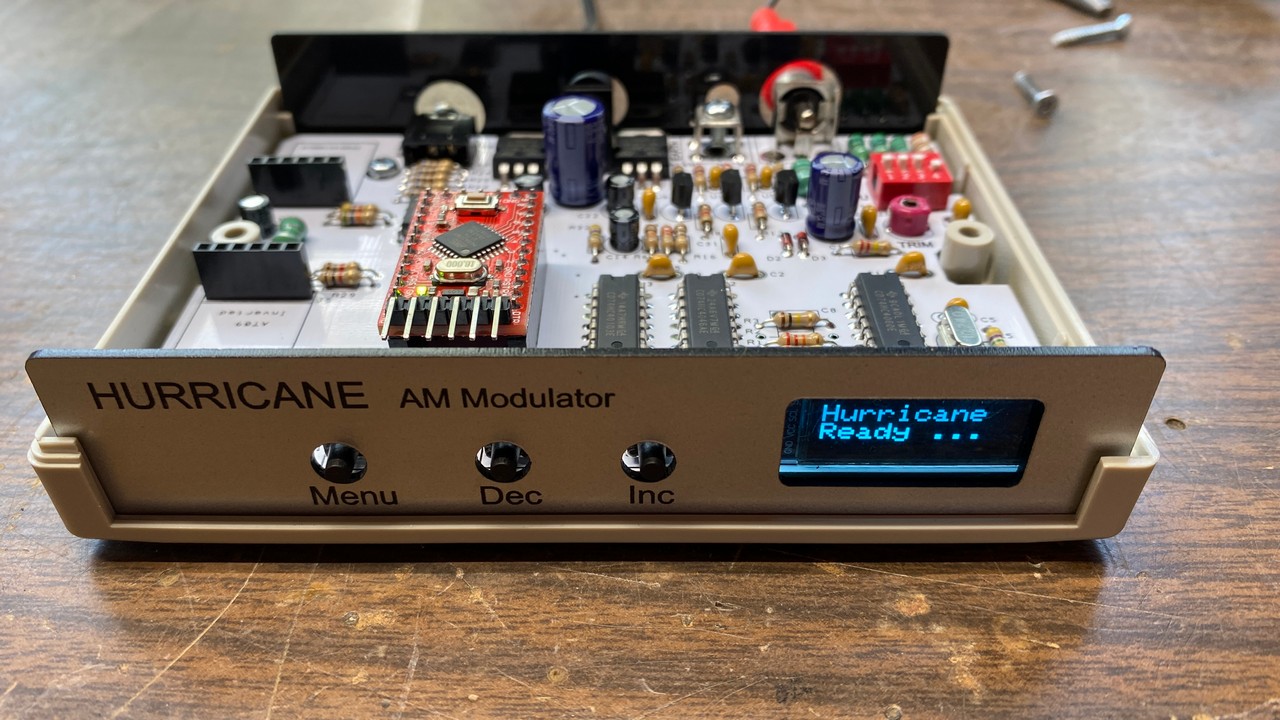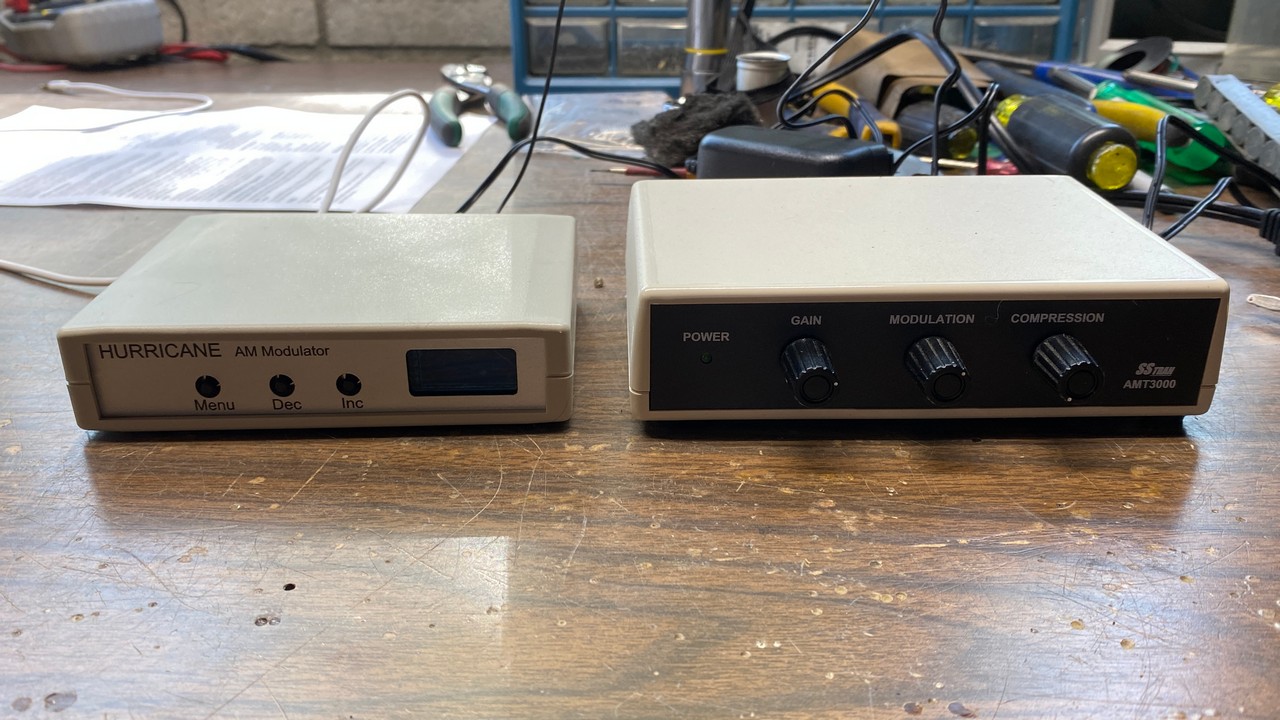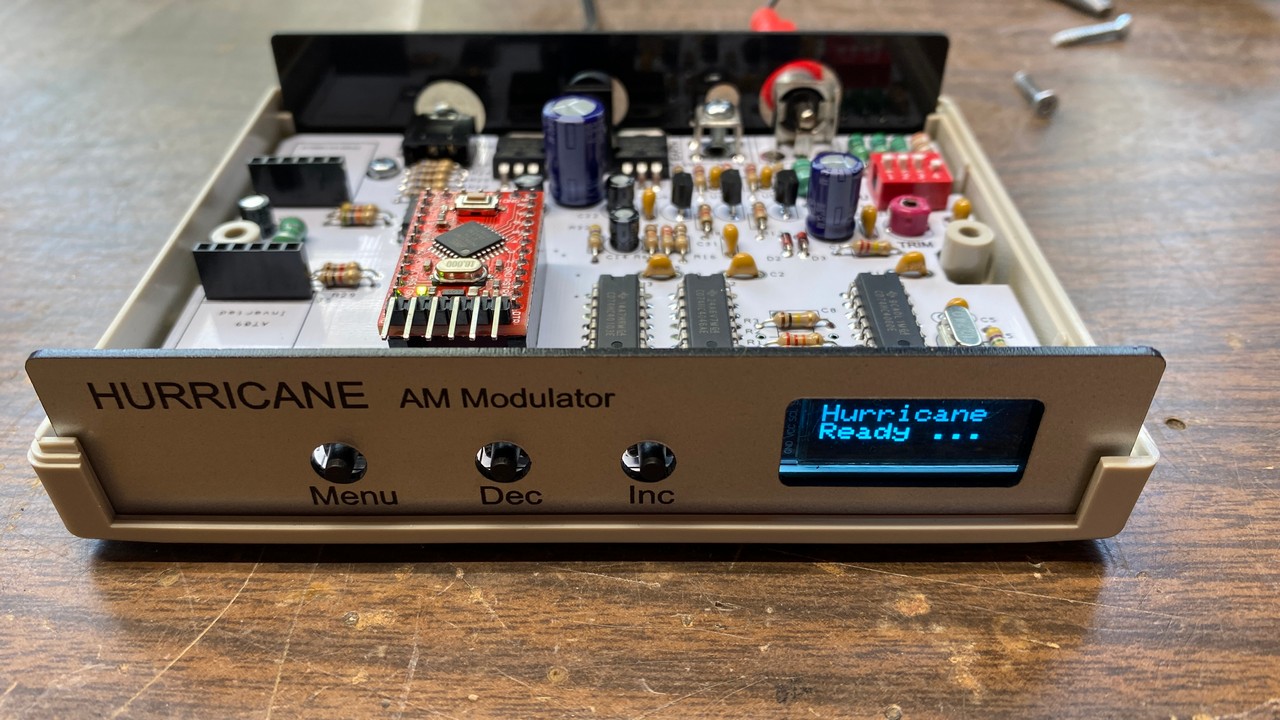
Collectors of vintage radios often would like to have something to listen to on their vintage radios other than the usual talking heads which fill the AM band these days. The simple answer for many of us is to use a small FCC Part 15 AM transmitter which only has a range that will cover one’s own home without interfering with local AM broadcast signals or being audible possibly beyond the houses next to you.
With am AM transmitter, some collectors prefer to broadcast old-time radio programs from the 1940s to their restored radios, while others will broadcast various types of music.
A few months ago, I decided that I would like to put my Part 15 SStran AMT3000 AM transmitter back on the air so I could have something to listen to on my working AM radios.
I have owned the SStran for several years, having received it as a birthday gift from Debbie. However, I had not used it for at least two years. I hooked it up to an old laptop for a program source, powered up the transmitter and laptop, and I was back in business.
Or so I thought.
I soon noticed that the SStran was barely audible only one floor above its location in the basement. And when I say one floor above, I mean that my home office is located literally right above the location where I had set up the SStran.
It should have been coming in loud and clear…but it was not.
I even pulled out the one working console radio I have in my office, an RCA model C15-3, and gave it a good going over to make sure it was operating at its peak potential. You can read about that here on this blog.
Finding that the RCA was operating fine, that only left one possibility for the poor reception, and that was the SStran itself.
The SStran was removed from service, and I began to look around for a replacement. Unfortunately, the company which produced the SStran kits is no longer in business, which is a shame as their SStran was an excellent product. Searching for a transmitter from a different manufacturer, I soon found something which looked like a good transmitter for home use, the 6V6 Electronics model Hurricane unit.
These transmitters are shipped fully assembled, from the UK.
I ordered one, knowing it would not arrive right away as it had to travel from England to here.
Well…
Actually, it went from England to Indianapolis (3 hours northeast of where I live) in less than a week. Pretty good, huh?
That’s when the fun began.
Apparently, the company which ships these to the USA from 6V6 Electronics uses FedEx to get them from the UK to the USA.
Keep in mind that this package was now only three hours from my home.
What happened? FedEx turned the package over to DHL, which then took the package to…Chicago.
It bounced around a few different Chicagoland locations before being shipped off to…St. Louis!
Once it arrived in St. Louis, it was turned over to USPS. As you know, I have been a critic of USPS in the past. Now, I have to be fair and tell you that once USPS had the transmitter, they shipped it from St. Louis to my home in only two days.
But I digress.

The box containing the transmitter has a dent in it. No wonder, having been bounced around through multiple cities and multiple carriers before being delivered.
The box was dented when it arrived here. I opened it up right away and was relieved to find that the transmitter itself had been packed well and had suffered no damage in its roundabout trip from the UK to southern Indiana.
A 10 foot antenna wire, an audio cable with a 3.5mm stereo plug on either end, and a power supply is included with the transmitter. The power supply comes with three different snap-in plugs, for use in many different countries. I immediately snapped in the American AC plug.

The Hurricane transmitter (left) is slightly smaller than the SStran AMT3000 (right).
As you can see in the photo above, the Hurricane is slightly smaller than the SStran it was going to replace. There are other differences as well. The SStran includes built-in compression, something the Hurricane does not have. However, the Hurricane more than makes up for that omission with a digital display. It can be purchased with a Bluetooth option to allow operation of the transmitter from a Bluetooth source. Another option allows the user to use his or her smart phone to control the transmitter via a different Bluetooth option.
I ordered mine without either option.
OPERATION
To operate the transmitter, one only needs to attach the power supply, plug in the furnished antenna lead and extend it as much as possible, plug in an audio source (unless you ordered the Bluetooth option in which case you would pair your Bluetooth audio source with the transmitter), plug in the power supply and you’re on the air.
The Menu button allows you to change what is displayed on the screen. You may choose frequency, VU meter, antenna voltage, modulation percentage, and audio level. You may also choose between displaying frequency in kHz or wavelength in meters. When in the frequency mode, the frequency may be changed using the Dec (decrease) or Inc (increase) buttons. And when in the audio level mode, the incoming audio level may be likewise decreased or increased with the same Dec or Inc buttons. These two buttons do not function in the VU Meter, Modulation, or antenna voltage modes.
The manufacturer recommends that the unit be grounded to avoid hum. However, I chose not to ground my Hurricane. I found that mine does not produce any audible hum in operation.
If you wish to operate your Hurricane at a frequency other than the one it was set to at the factory, some adjustments will need to be performed.
My transmitter was shipped to me preset to 1600 kHz. That would be ok; however, I own some older sets such as Philco models 20, 21, 70, and 90 cathedrals, none of which tune above 1510 kHz. Therefore, I needed to change the transmitter to a lower frequency.
Changing the frequency requires the owner to open up the unit and change the setting of some DIP switches to properly match the antenna to the transmitter at the desired operating frequency. Fear not, this is actually an easy task as long as you follow the enclosed instructions.
You will notice in the photo below that, with the lid removed, a set of four tiny slide switches may be seen on the right side of the unit, within a red plastic housing. These are the DIP switches previously mentioned. The instructions refer to this small unit as the ATU (antenna tuning unit) switch.

The Hurricane opened up to adjust the slide switches.
Here, the instructions leave out an important point. You are instructed to adjust the DIP switches according to the chart in the instructions to a point of best resonance, but you are not told how to achieve that resonance. Fortunately, the transmitter has a built-in voltmeter to aid you in finding the correct setting. And, in a similar manner to the SStran, the switches are then set so you end up with the highest voltage possible.
I did not change switch settings with the power on. Instead, I tried one setting, noted the voltage on the display, unplugged the unit, changed the switches, and tried again. Eventually, I found a setting which gave me the highest voltage at the frequency I had selected, and at that point I turned the transmitter off and reattached the top cover.
Once the initial adjustments are made, the unit is ready to operate. As mentioned earlier, from here it is simply a matter of extending the antenna, plugging everything in, and broadcasting.
I have had my Hurricane in operation nonstop, 24/7, for a month now and it is working very well. It provides the same coverage of the entire house as did the SStran. I have that same laptop now connected to my Hurricane, and it is broadcasting 1970s popular music with jingles from a popular music station of the time period. For me, this brings back pleasant memories of my teenage years, even if the programming is decades newer than the radios playing the music.
If you wish to purchase one of your own, be advised that these are manufactured in European (EU) and US versions. You will want to be sure you order the US version, as it will have the proper 10 kHz spacing between AM channels. The EU version has 9 kHz spacing between channels. While the European version could be used with vintage radios with analog tuning, if you have a newer digitally tuned AM radio in your home, you will not be able to properly receive most of the frequencies from the EU version transmitter! For example, a digitally tuned AM radio designed for use in the USA will only tune in an AM station every 10 kHz. If you had an EU Hurricane transmitter, and had it set to broadcast at, say, 765 kHz, you could receive the station on your vintage radio but not on your modern digitally tuned AM radio. (You would likely hear it at 760 and 770, but you would not be able to fully tune it in.)
Long story short – avoid the headaches; buy the US version Hurricane, not the EU version.
6V6 Electronics also produces a lower cost Spitfire transmitter, which has no digital readout. If you wished to purchase this version instead of the Hurricane, note that this unit is also made in US and EU versions, so pick the proper one when ordering.
They also sell a Tornado (10 watt) transmitter as well as a Mosquito (1 watt) unit. Do not purchase these, as they are illegal to operate in the USA without an FCC license.
You may see all their products here.
I am very happy with my purchase of a Hurricane transmitter and I can heartily recommend this to any of you who may be interested in a home AM transmitter.